NURS-FPX4020: Improvement Plan Tool Kit for Healthcare Safety
VerifiedAdded on 2022/08/26
|19
|4181
|13
Project
AI Summary
This improvement plan toolkit aims to equip nurses with the tools and knowledge necessary to implement and support quality and safety improvement initiatives within an adult medical-surgical unit. The toolkit is structured into four key areas, each supported by a selection of annotated resources: inclusive collaboration and open communication among staff, organizational climate and its impact on patient outcomes, leadership and work environment safety, and performance measure development and endorsement. The toolkit provides a comprehensive overview of relevant research and guidelines, drawing from 12 scholarly sources. It emphasizes the importance of teamwork, effective communication, organizational culture, and evidence-based practices to enhance patient safety and the quality of care. Key topics include improving team collaboration, understanding the impact of organizational climate on patient outcomes, fostering effective leadership, and developing and endorsing performance measures. The toolkit serves as a valuable resource for nursing students and healthcare professionals seeking to improve care delivery and patient safety.
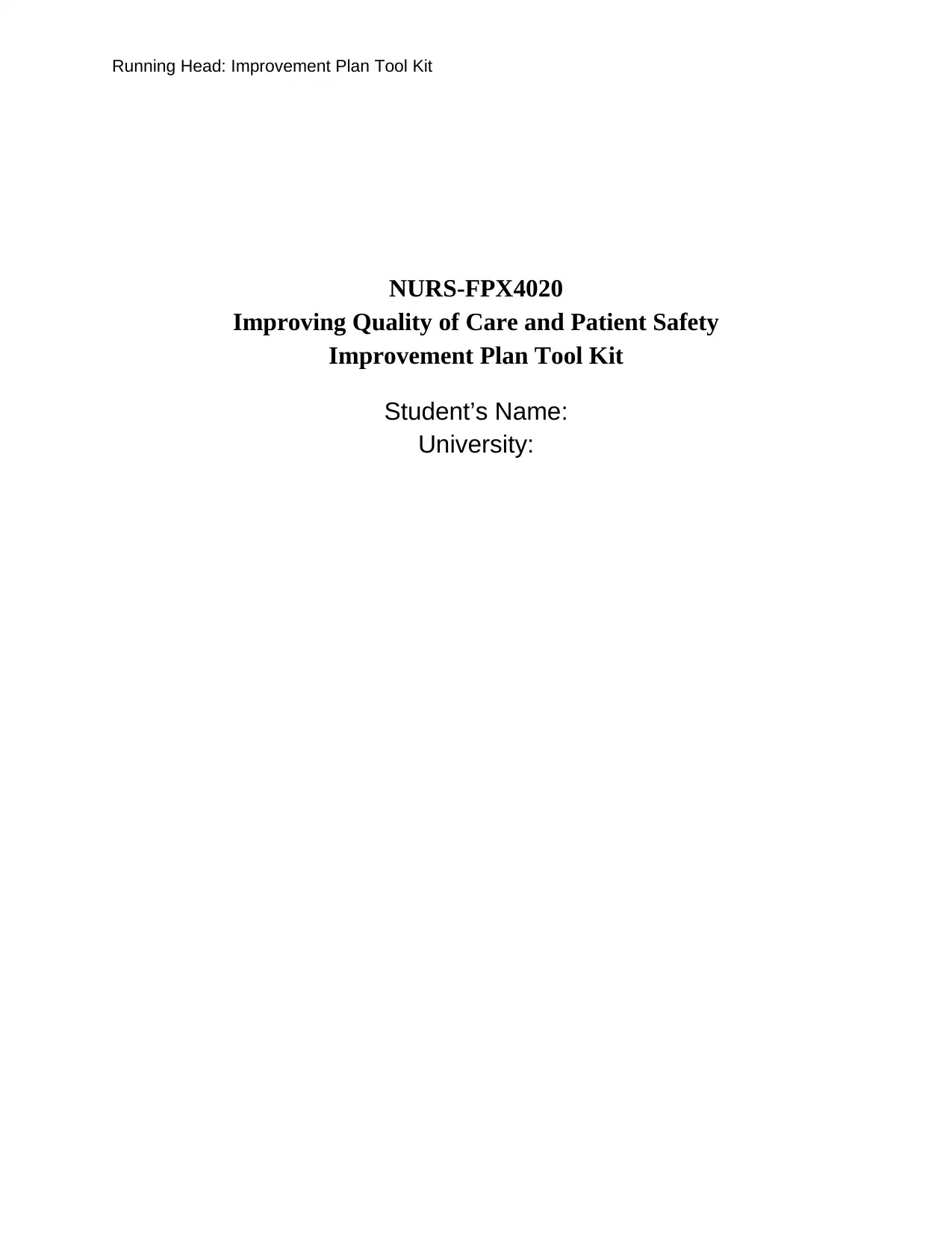
Running Head: Improvement Plan Tool Kit
NURS-FPX4020
Improving Quality of Care and Patient Safety
Improvement Plan Tool Kit
Student’s Name:
University:
NURS-FPX4020
Improving Quality of Care and Patient Safety
Improvement Plan Tool Kit
Student’s Name:
University:
Paraphrase This Document
Need a fresh take? Get an instant paraphrase of this document with our AI Paraphraser
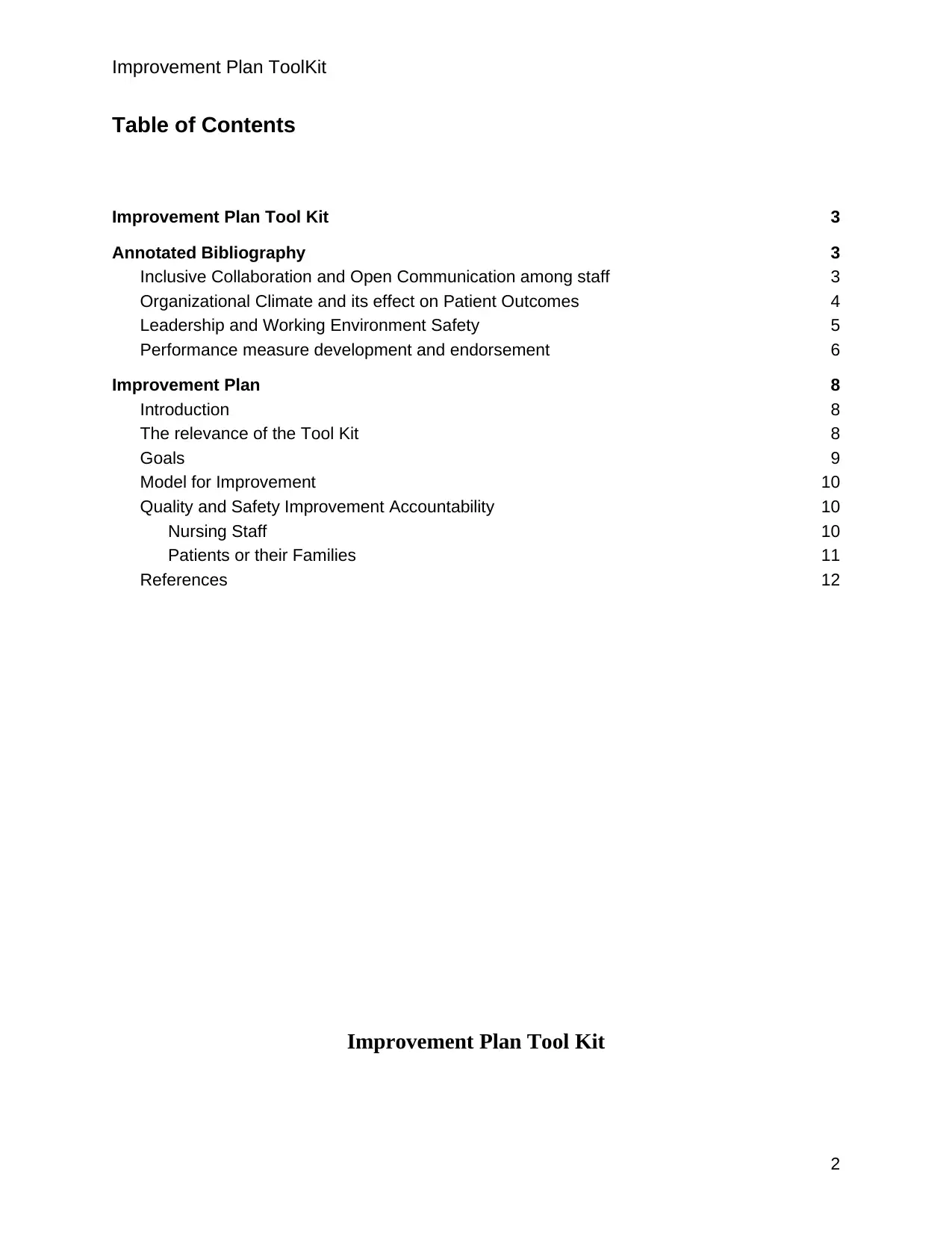
Improvement Plan ToolKit
Table of Contents
Improvement Plan Tool Kit 3
Annotated Bibliography 3
Inclusive Collaboration and Open Communication among staff 3
Organizational Climate and its effect on Patient Outcomes 4
Leadership and Working Environment Safety 5
Performance measure development and endorsement 6
Improvement Plan 8
Introduction 8
The relevance of the Tool Kit 8
Goals 9
Model for Improvement 10
Quality and Safety Improvement Accountability 10
Nursing Staff 10
Patients or their Families 11
References 12
Improvement Plan Tool Kit
2
Table of Contents
Improvement Plan Tool Kit 3
Annotated Bibliography 3
Inclusive Collaboration and Open Communication among staff 3
Organizational Climate and its effect on Patient Outcomes 4
Leadership and Working Environment Safety 5
Performance measure development and endorsement 6
Improvement Plan 8
Introduction 8
The relevance of the Tool Kit 8
Goals 9
Model for Improvement 10
Quality and Safety Improvement Accountability 10
Nursing Staff 10
Patients or their Families 11
References 12
Improvement Plan Tool Kit
2
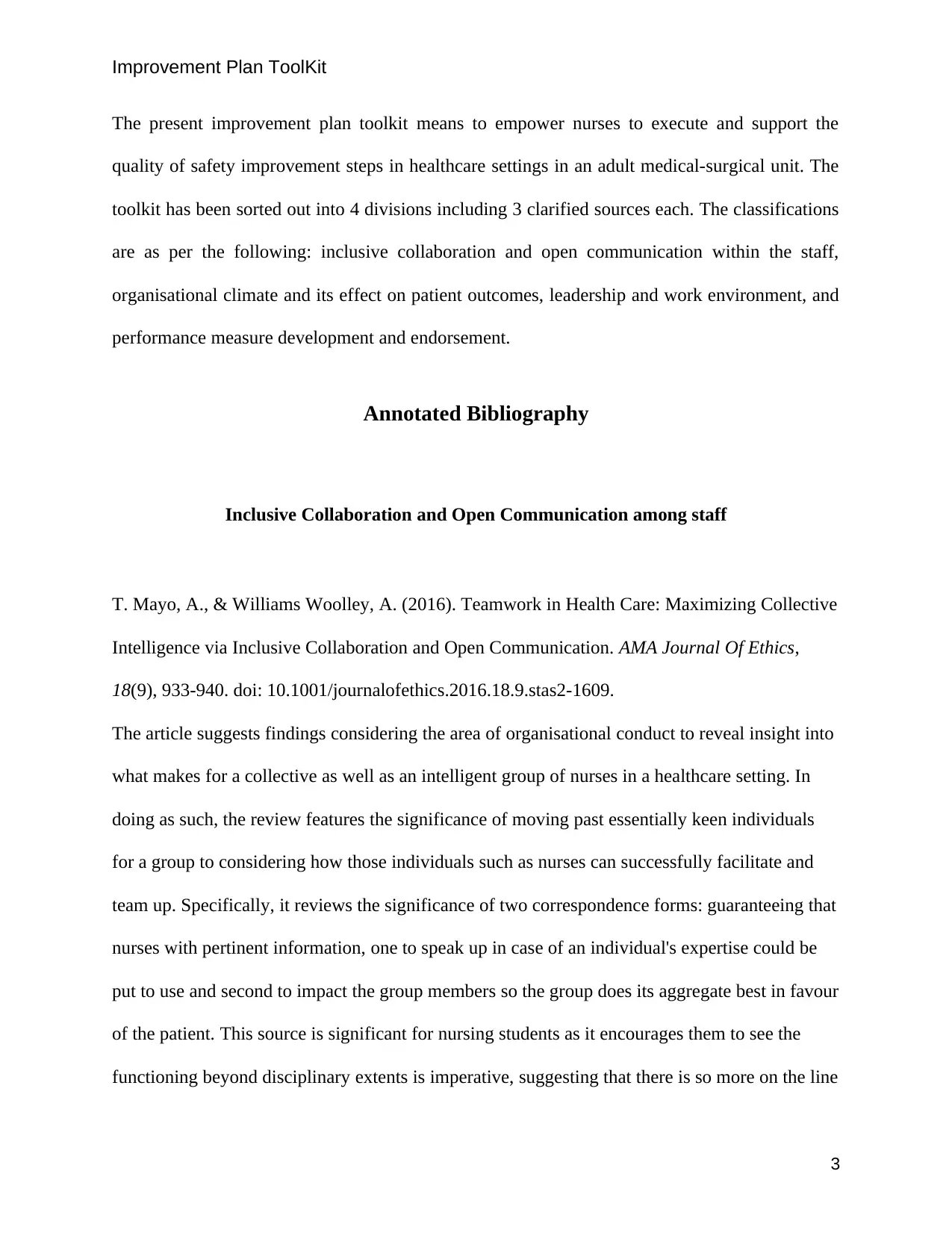
Improvement Plan ToolKit
The present improvement plan toolkit means to empower nurses to execute and support the
quality of safety improvement steps in healthcare settings in an adult medical-surgical unit. The
toolkit has been sorted out into 4 divisions including 3 clarified sources each. The classifications
are as per the following: inclusive collaboration and open communication within the staff,
organisational climate and its effect on patient outcomes, leadership and work environment, and
performance measure development and endorsement.
Annotated Bibliography
Inclusive Collaboration and Open Communication among staff
T. Mayo, A., & Williams Woolley, A. (2016). Teamwork in Health Care: Maximizing Collective
Intelligence via Inclusive Collaboration and Open Communication. AMA Journal Of Ethics,
18(9), 933-940. doi: 10.1001/journalofethics.2016.18.9.stas2-1609.
The article suggests findings considering the area of organisational conduct to reveal insight into
what makes for a collective as well as an intelligent group of nurses in a healthcare setting. In
doing as such, the review features the significance of moving past essentially keen individuals
for a group to considering how those individuals such as nurses can successfully facilitate and
team up. Specifically, it reviews the significance of two correspondence forms: guaranteeing that
nurses with pertinent information, one to speak up in case of an individual's expertise could be
put to use and second to impact the group members so the group does its aggregate best in favour
of the patient. This source is significant for nursing students as it encourages them to see the
functioning beyond disciplinary extents is imperative, suggesting that there is so more on the line
3
The present improvement plan toolkit means to empower nurses to execute and support the
quality of safety improvement steps in healthcare settings in an adult medical-surgical unit. The
toolkit has been sorted out into 4 divisions including 3 clarified sources each. The classifications
are as per the following: inclusive collaboration and open communication within the staff,
organisational climate and its effect on patient outcomes, leadership and work environment, and
performance measure development and endorsement.
Annotated Bibliography
Inclusive Collaboration and Open Communication among staff
T. Mayo, A., & Williams Woolley, A. (2016). Teamwork in Health Care: Maximizing Collective
Intelligence via Inclusive Collaboration and Open Communication. AMA Journal Of Ethics,
18(9), 933-940. doi: 10.1001/journalofethics.2016.18.9.stas2-1609.
The article suggests findings considering the area of organisational conduct to reveal insight into
what makes for a collective as well as an intelligent group of nurses in a healthcare setting. In
doing as such, the review features the significance of moving past essentially keen individuals
for a group to considering how those individuals such as nurses can successfully facilitate and
team up. Specifically, it reviews the significance of two correspondence forms: guaranteeing that
nurses with pertinent information, one to speak up in case of an individual's expertise could be
put to use and second to impact the group members so the group does its aggregate best in favour
of the patient. This source is significant for nursing students as it encourages them to see the
functioning beyond disciplinary extents is imperative, suggesting that there is so more on the line
3
⊘ This is a preview!⊘
Do you want full access?
Subscribe today to unlock all pages.

Trusted by 1+ million students worldwide
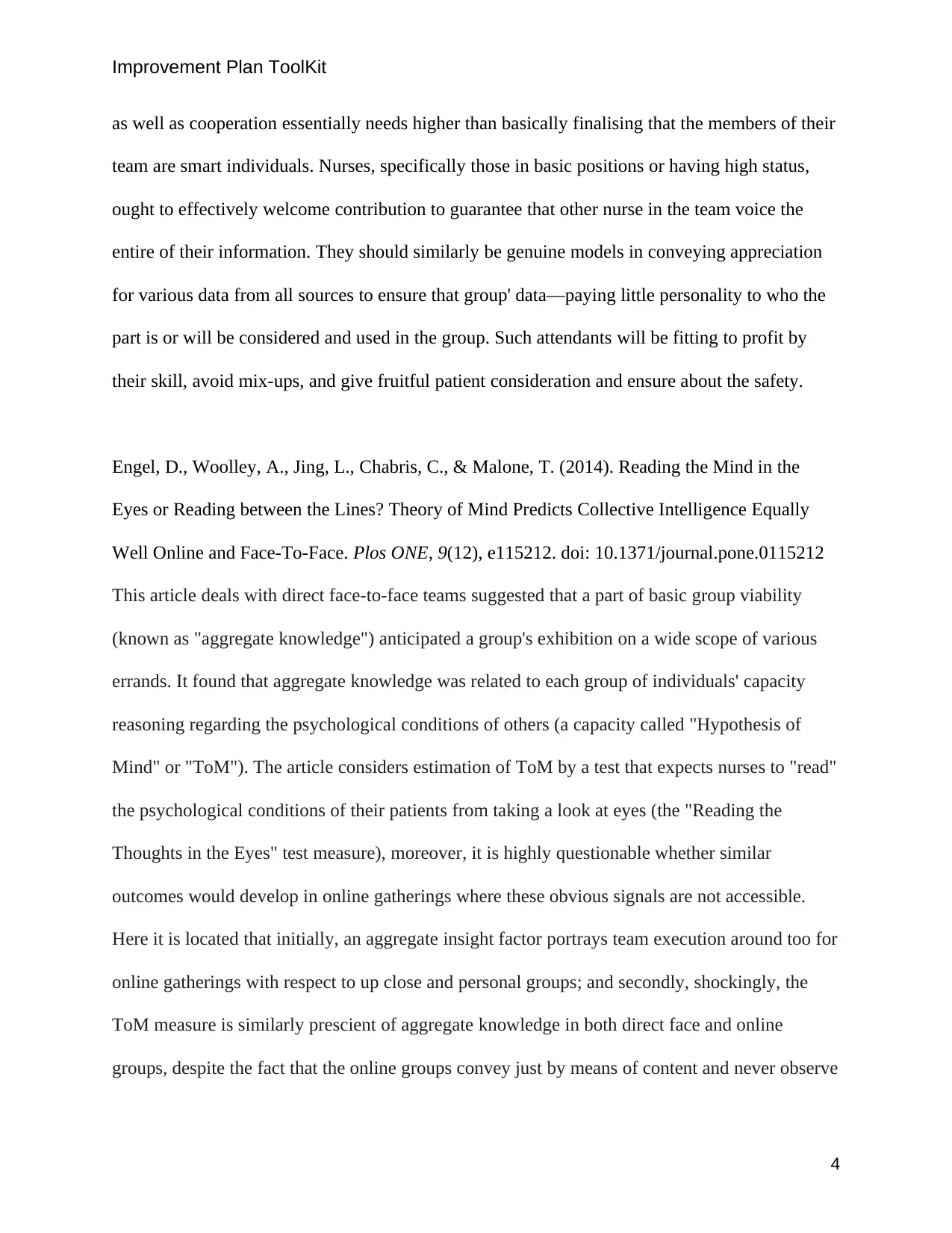
Improvement Plan ToolKit
as well as cooperation essentially needs higher than basically finalising that the members of their
team are smart individuals. Nurses, specifically those in basic positions or having high status,
ought to effectively welcome contribution to guarantee that other nurse in the team voice the
entire of their information. They should similarly be genuine models in conveying appreciation
for various data from all sources to ensure that group' data—paying little personality to who the
part is or will be considered and used in the group. Such attendants will be fitting to profit by
their skill, avoid mix-ups, and give fruitful patient consideration and ensure about the safety.
Engel, D., Woolley, A., Jing, L., Chabris, C., & Malone, T. (2014). Reading the Mind in the
Eyes or Reading between the Lines? Theory of Mind Predicts Collective Intelligence Equally
Well Online and Face-To-Face. Plos ONE, 9(12), e115212. doi: 10.1371/journal.pone.0115212
This article deals with direct face-to-face teams suggested that a part of basic group viability
(known as "aggregate knowledge") anticipated a group's exhibition on a wide scope of various
errands. It found that aggregate knowledge was related to each group of individuals' capacity
reasoning regarding the psychological conditions of others (a capacity called "Hypothesis of
Mind" or "ToM"). The article considers estimation of ToM by a test that expects nurses to "read"
the psychological conditions of their patients from taking a look at eyes (the "Reading the
Thoughts in the Eyes" test measure), moreover, it is highly questionable whether similar
outcomes would develop in online gatherings where these obvious signals are not accessible.
Here it is located that initially, an aggregate insight factor portrays team execution around too for
online gatherings with respect to up close and personal groups; and secondly, shockingly, the
ToM measure is similarly prescient of aggregate knowledge in both direct face and online
groups, despite the fact that the online groups convey just by means of content and never observe
4
as well as cooperation essentially needs higher than basically finalising that the members of their
team are smart individuals. Nurses, specifically those in basic positions or having high status,
ought to effectively welcome contribution to guarantee that other nurse in the team voice the
entire of their information. They should similarly be genuine models in conveying appreciation
for various data from all sources to ensure that group' data—paying little personality to who the
part is or will be considered and used in the group. Such attendants will be fitting to profit by
their skill, avoid mix-ups, and give fruitful patient consideration and ensure about the safety.
Engel, D., Woolley, A., Jing, L., Chabris, C., & Malone, T. (2014). Reading the Mind in the
Eyes or Reading between the Lines? Theory of Mind Predicts Collective Intelligence Equally
Well Online and Face-To-Face. Plos ONE, 9(12), e115212. doi: 10.1371/journal.pone.0115212
This article deals with direct face-to-face teams suggested that a part of basic group viability
(known as "aggregate knowledge") anticipated a group's exhibition on a wide scope of various
errands. It found that aggregate knowledge was related to each group of individuals' capacity
reasoning regarding the psychological conditions of others (a capacity called "Hypothesis of
Mind" or "ToM"). The article considers estimation of ToM by a test that expects nurses to "read"
the psychological conditions of their patients from taking a look at eyes (the "Reading the
Thoughts in the Eyes" test measure), moreover, it is highly questionable whether similar
outcomes would develop in online gatherings where these obvious signals are not accessible.
Here it is located that initially, an aggregate insight factor portrays team execution around too for
online gatherings with respect to up close and personal groups; and secondly, shockingly, the
ToM measure is similarly prescient of aggregate knowledge in both direct face and online
groups, despite the fact that the online groups convey just by means of content and never observe
4
Paraphrase This Document
Need a fresh take? Get an instant paraphrase of this document with our AI Paraphraser
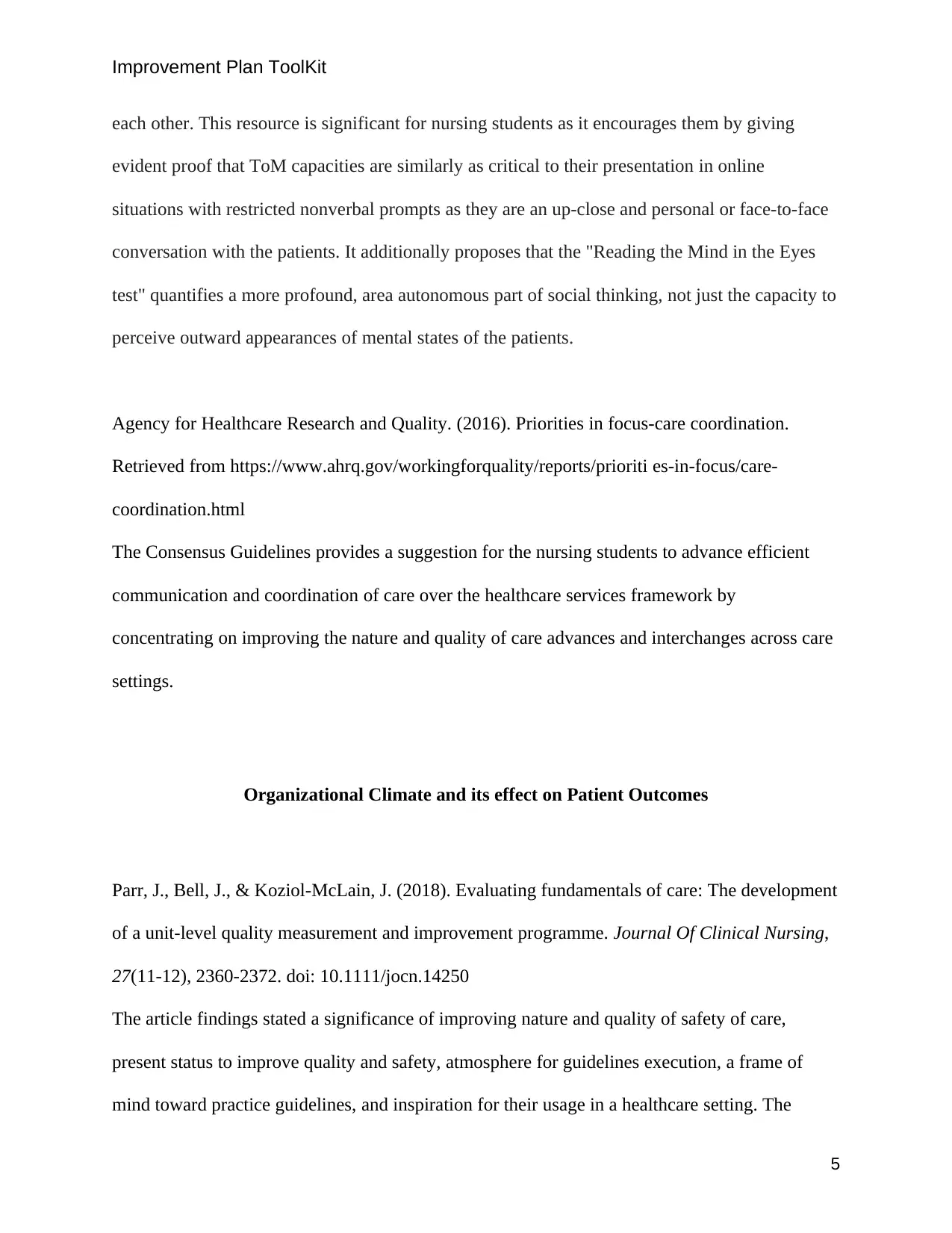
Improvement Plan ToolKit
each other. This resource is significant for nursing students as it encourages them by giving
evident proof that ToM capacities are similarly as critical to their presentation in online
situations with restricted nonverbal prompts as they are an up-close and personal or face-to-face
conversation with the patients. It additionally proposes that the "Reading the Mind in the Eyes
test" quantifies a more profound, area autonomous part of social thinking, not just the capacity to
perceive outward appearances of mental states of the patients.
Agency for Healthcare Research and Quality. (2016). Priorities in focus-care coordination.
Retrieved from https://www.ahrq.gov/workingforquality/reports/prioriti es-in-focus/care-
coordination.html
The Consensus Guidelines provides a suggestion for the nursing students to advance efficient
communication and coordination of care over the healthcare services framework by
concentrating on improving the nature and quality of care advances and interchanges across care
settings.
Organizational Climate and its effect on Patient Outcomes
Parr, J., Bell, J., & Koziol-McLain, J. (2018). Evaluating fundamentals of care: The development
of a unit-level quality measurement and improvement programme. Journal Of Clinical Nursing,
27(11-12), 2360-2372. doi: 10.1111/jocn.14250
The article findings stated a significance of improving nature and quality of safety of care,
present status to improve quality and safety, atmosphere for guidelines execution, a frame of
mind toward practice guidelines, and inspiration for their usage in a healthcare setting. The
5
each other. This resource is significant for nursing students as it encourages them by giving
evident proof that ToM capacities are similarly as critical to their presentation in online
situations with restricted nonverbal prompts as they are an up-close and personal or face-to-face
conversation with the patients. It additionally proposes that the "Reading the Mind in the Eyes
test" quantifies a more profound, area autonomous part of social thinking, not just the capacity to
perceive outward appearances of mental states of the patients.
Agency for Healthcare Research and Quality. (2016). Priorities in focus-care coordination.
Retrieved from https://www.ahrq.gov/workingforquality/reports/prioriti es-in-focus/care-
coordination.html
The Consensus Guidelines provides a suggestion for the nursing students to advance efficient
communication and coordination of care over the healthcare services framework by
concentrating on improving the nature and quality of care advances and interchanges across care
settings.
Organizational Climate and its effect on Patient Outcomes
Parr, J., Bell, J., & Koziol-McLain, J. (2018). Evaluating fundamentals of care: The development
of a unit-level quality measurement and improvement programme. Journal Of Clinical Nursing,
27(11-12), 2360-2372. doi: 10.1111/jocn.14250
The article findings stated a significance of improving nature and quality of safety of care,
present status to improve quality and safety, atmosphere for guidelines execution, a frame of
mind toward practice guidelines, and inspiration for their usage in a healthcare setting. The
5
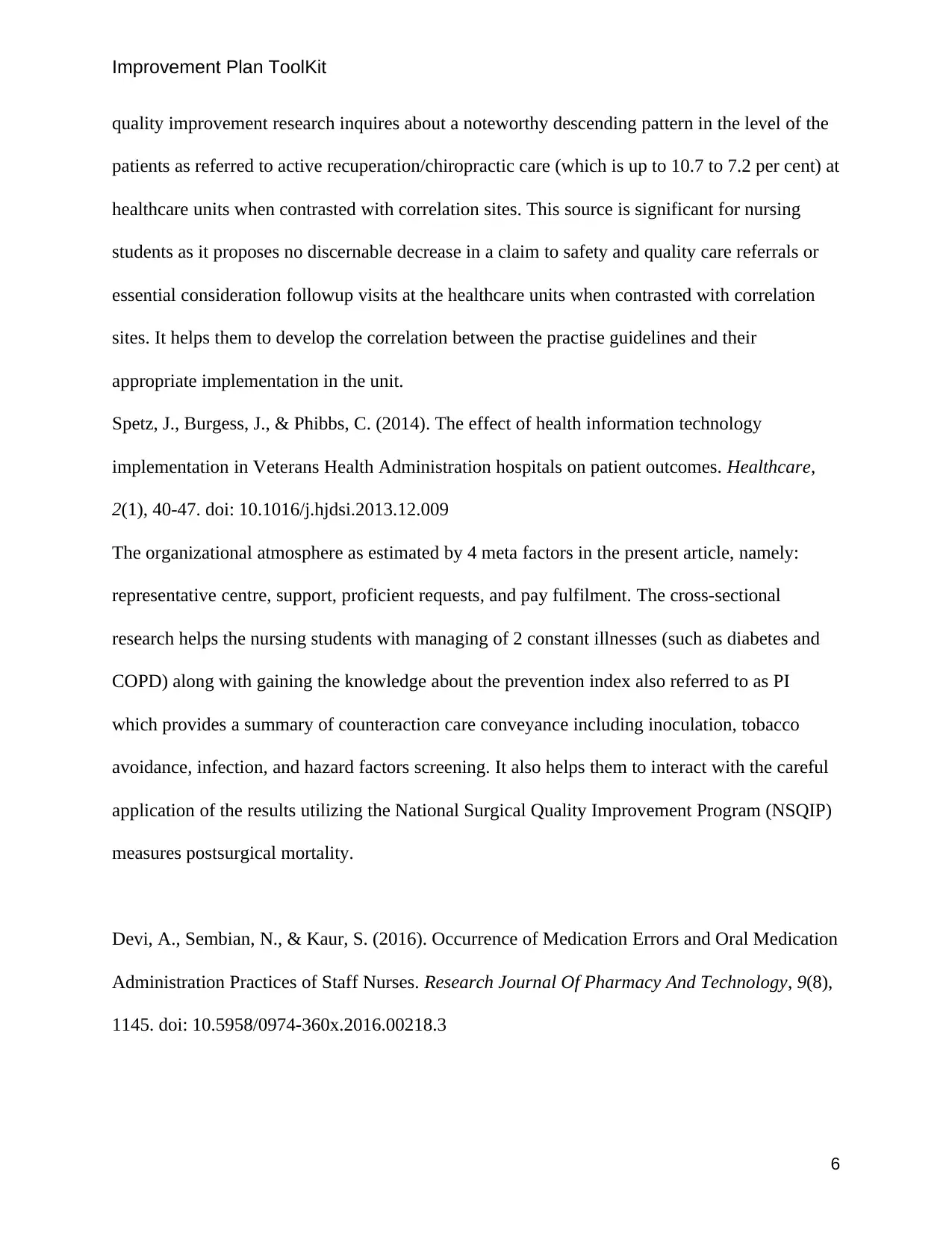
Improvement Plan ToolKit
quality improvement research inquires about a noteworthy descending pattern in the level of the
patients as referred to active recuperation/chiropractic care (which is up to 10.7 to 7.2 per cent) at
healthcare units when contrasted with correlation sites. This source is significant for nursing
students as it proposes no discernable decrease in a claim to safety and quality care referrals or
essential consideration followup visits at the healthcare units when contrasted with correlation
sites. It helps them to develop the correlation between the practise guidelines and their
appropriate implementation in the unit.
Spetz, J., Burgess, J., & Phibbs, C. (2014). The effect of health information technology
implementation in Veterans Health Administration hospitals on patient outcomes. Healthcare,
2(1), 40-47. doi: 10.1016/j.hjdsi.2013.12.009
The organizational atmosphere as estimated by 4 meta factors in the present article, namely:
representative centre, support, proficient requests, and pay fulfilment. The cross-sectional
research helps the nursing students with managing of 2 constant illnesses (such as diabetes and
COPD) along with gaining the knowledge about the prevention index also referred to as PI
which provides a summary of counteraction care conveyance including inoculation, tobacco
avoidance, infection, and hazard factors screening. It also helps them to interact with the careful
application of the results utilizing the National Surgical Quality Improvement Program (NSQIP)
measures postsurgical mortality.
Devi, A., Sembian, N., & Kaur, S. (2016). Occurrence of Medication Errors and Oral Medication
Administration Practices of Staff Nurses. Research Journal Of Pharmacy And Technology, 9(8),
1145. doi: 10.5958/0974-360x.2016.00218.3
6
quality improvement research inquires about a noteworthy descending pattern in the level of the
patients as referred to active recuperation/chiropractic care (which is up to 10.7 to 7.2 per cent) at
healthcare units when contrasted with correlation sites. This source is significant for nursing
students as it proposes no discernable decrease in a claim to safety and quality care referrals or
essential consideration followup visits at the healthcare units when contrasted with correlation
sites. It helps them to develop the correlation between the practise guidelines and their
appropriate implementation in the unit.
Spetz, J., Burgess, J., & Phibbs, C. (2014). The effect of health information technology
implementation in Veterans Health Administration hospitals on patient outcomes. Healthcare,
2(1), 40-47. doi: 10.1016/j.hjdsi.2013.12.009
The organizational atmosphere as estimated by 4 meta factors in the present article, namely:
representative centre, support, proficient requests, and pay fulfilment. The cross-sectional
research helps the nursing students with managing of 2 constant illnesses (such as diabetes and
COPD) along with gaining the knowledge about the prevention index also referred to as PI
which provides a summary of counteraction care conveyance including inoculation, tobacco
avoidance, infection, and hazard factors screening. It also helps them to interact with the careful
application of the results utilizing the National Surgical Quality Improvement Program (NSQIP)
measures postsurgical mortality.
Devi, A., Sembian, N., & Kaur, S. (2016). Occurrence of Medication Errors and Oral Medication
Administration Practices of Staff Nurses. Research Journal Of Pharmacy And Technology, 9(8),
1145. doi: 10.5958/0974-360x.2016.00218.3
6
⊘ This is a preview!⊘
Do you want full access?
Subscribe today to unlock all pages.

Trusted by 1+ million students worldwide
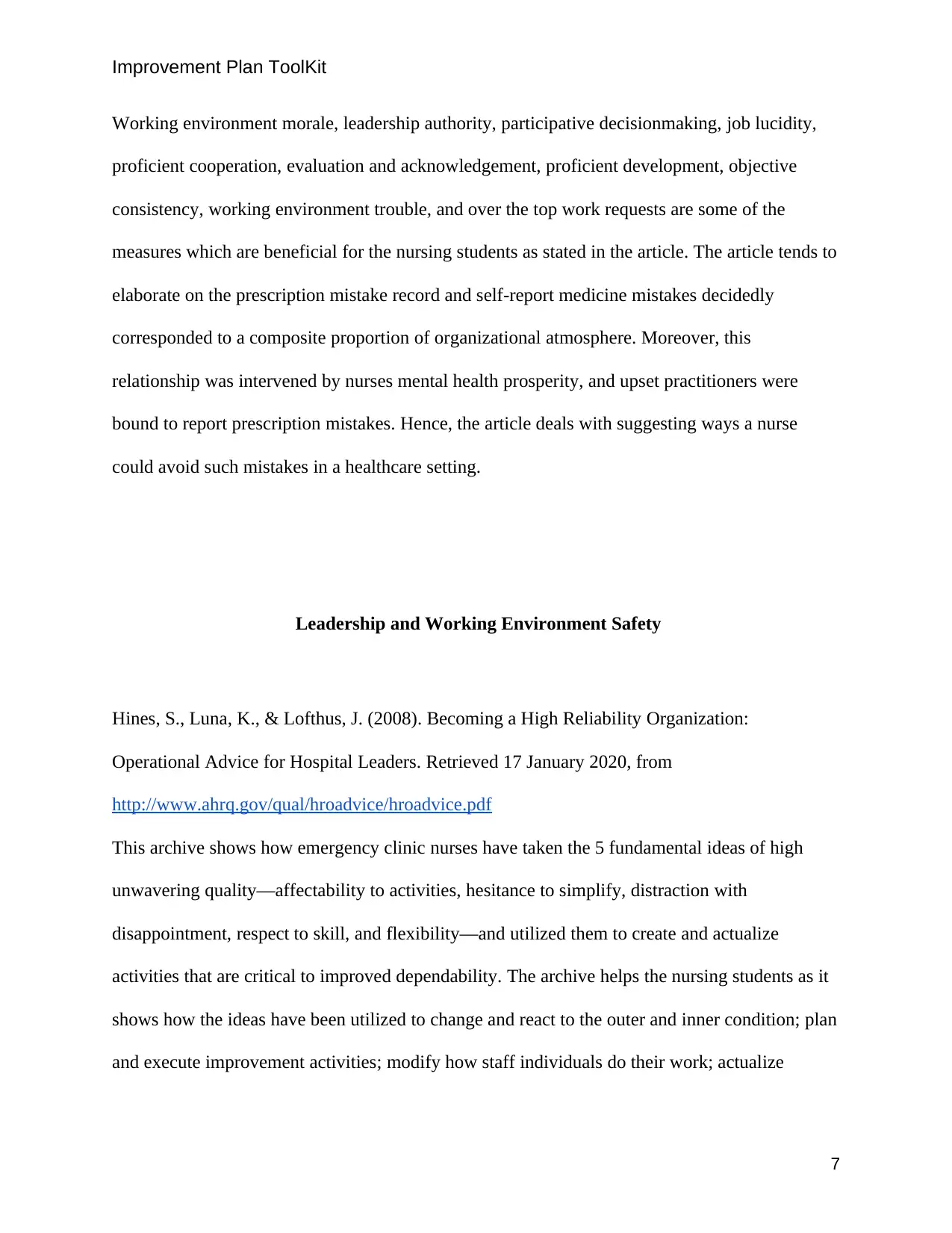
Improvement Plan ToolKit
Working environment morale, leadership authority, participative decisionmaking, job lucidity,
proficient cooperation, evaluation and acknowledgement, proficient development, objective
consistency, working environment trouble, and over the top work requests are some of the
measures which are beneficial for the nursing students as stated in the article. The article tends to
elaborate on the prescription mistake record and self-report medicine mistakes decidedly
corresponded to a composite proportion of organizational atmosphere. Moreover, this
relationship was intervened by nurses mental health prosperity, and upset practitioners were
bound to report prescription mistakes. Hence, the article deals with suggesting ways a nurse
could avoid such mistakes in a healthcare setting.
Leadership and Working Environment Safety
Hines, S., Luna, K., & Lofthus, J. (2008). Becoming a High Reliability Organization:
Operational Advice for Hospital Leaders. Retrieved 17 January 2020, from
http://www.ahrq.gov/qual/hroadvice/hroadvice.pdf
This archive shows how emergency clinic nurses have taken the 5 fundamental ideas of high
unwavering quality—affectability to activities, hesitance to simplify, distraction with
disappointment, respect to skill, and flexibility—and utilized them to create and actualize
activities that are critical to improved dependability. The archive helps the nursing students as it
shows how the ideas have been utilized to change and react to the outer and inner condition; plan
and execute improvement activities; modify how staff individuals do their work; actualize
7
Working environment morale, leadership authority, participative decisionmaking, job lucidity,
proficient cooperation, evaluation and acknowledgement, proficient development, objective
consistency, working environment trouble, and over the top work requests are some of the
measures which are beneficial for the nursing students as stated in the article. The article tends to
elaborate on the prescription mistake record and self-report medicine mistakes decidedly
corresponded to a composite proportion of organizational atmosphere. Moreover, this
relationship was intervened by nurses mental health prosperity, and upset practitioners were
bound to report prescription mistakes. Hence, the article deals with suggesting ways a nurse
could avoid such mistakes in a healthcare setting.
Leadership and Working Environment Safety
Hines, S., Luna, K., & Lofthus, J. (2008). Becoming a High Reliability Organization:
Operational Advice for Hospital Leaders. Retrieved 17 January 2020, from
http://www.ahrq.gov/qual/hroadvice/hroadvice.pdf
This archive shows how emergency clinic nurses have taken the 5 fundamental ideas of high
unwavering quality—affectability to activities, hesitance to simplify, distraction with
disappointment, respect to skill, and flexibility—and utilized them to create and actualize
activities that are critical to improved dependability. The archive helps the nursing students as it
shows how the ideas have been utilized to change and react to the outer and inner condition; plan
and execute improvement activities; modify how staff individuals do their work; actualize
7
Paraphrase This Document
Need a fresh take? Get an instant paraphrase of this document with our AI Paraphraser
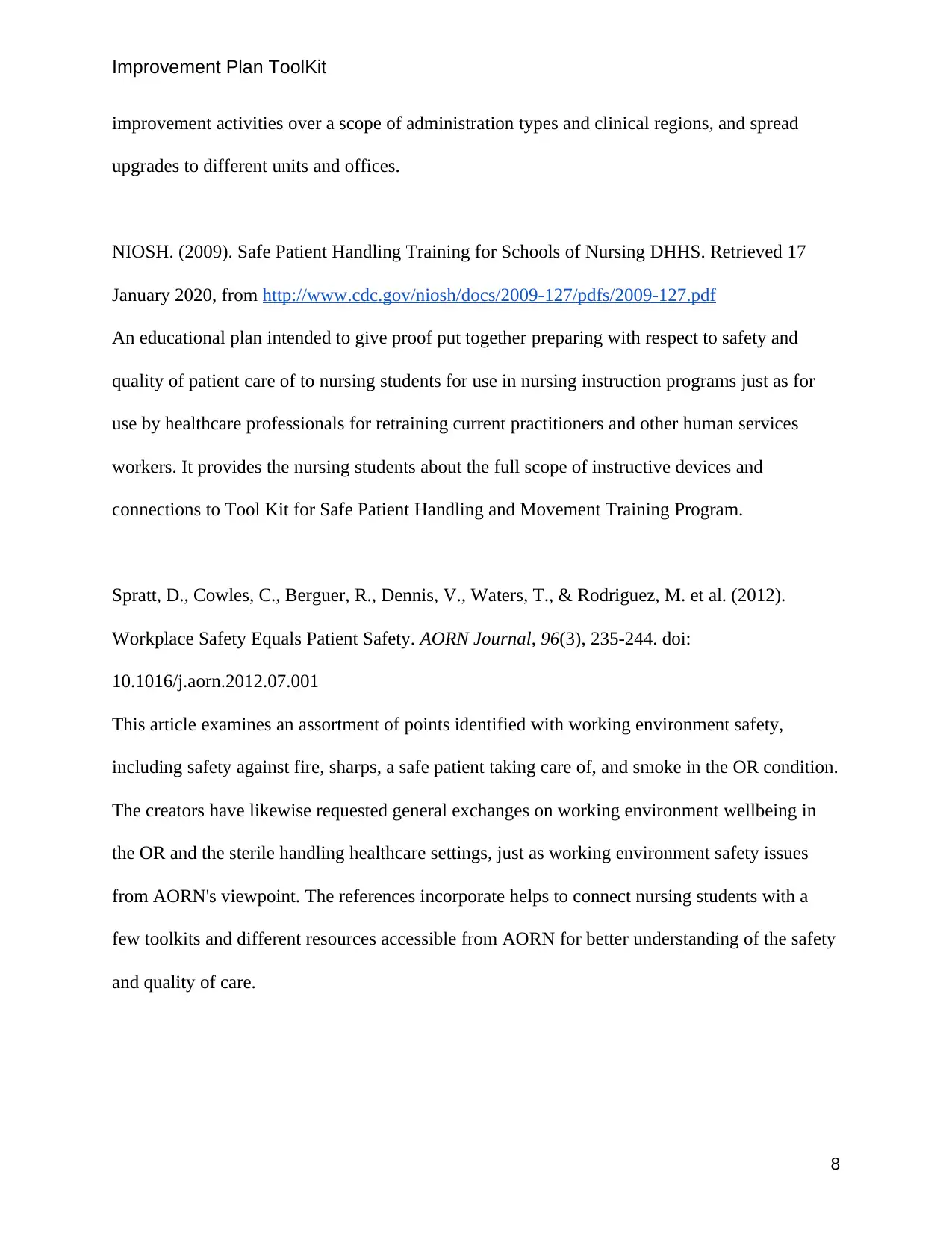
Improvement Plan ToolKit
improvement activities over a scope of administration types and clinical regions, and spread
upgrades to different units and offices.
NIOSH. (2009). Safe Patient Handling Training for Schools of Nursing DHHS. Retrieved 17
January 2020, from http://www.cdc.gov/niosh/docs/2009-127/pdfs/2009-127.pdf
An educational plan intended to give proof put together preparing with respect to safety and
quality of patient care of to nursing students for use in nursing instruction programs just as for
use by healthcare professionals for retraining current practitioners and other human services
workers. It provides the nursing students about the full scope of instructive devices and
connections to Tool Kit for Safe Patient Handling and Movement Training Program.
Spratt, D., Cowles, C., Berguer, R., Dennis, V., Waters, T., & Rodriguez, M. et al. (2012).
Workplace Safety Equals Patient Safety. AORN Journal, 96(3), 235-244. doi:
10.1016/j.aorn.2012.07.001
This article examines an assortment of points identified with working environment safety,
including safety against fire, sharps, a safe patient taking care of, and smoke in the OR condition.
The creators have likewise requested general exchanges on working environment wellbeing in
the OR and the sterile handling healthcare settings, just as working environment safety issues
from AORN's viewpoint. The references incorporate helps to connect nursing students with a
few toolkits and different resources accessible from AORN for better understanding of the safety
and quality of care.
8
improvement activities over a scope of administration types and clinical regions, and spread
upgrades to different units and offices.
NIOSH. (2009). Safe Patient Handling Training for Schools of Nursing DHHS. Retrieved 17
January 2020, from http://www.cdc.gov/niosh/docs/2009-127/pdfs/2009-127.pdf
An educational plan intended to give proof put together preparing with respect to safety and
quality of patient care of to nursing students for use in nursing instruction programs just as for
use by healthcare professionals for retraining current practitioners and other human services
workers. It provides the nursing students about the full scope of instructive devices and
connections to Tool Kit for Safe Patient Handling and Movement Training Program.
Spratt, D., Cowles, C., Berguer, R., Dennis, V., Waters, T., & Rodriguez, M. et al. (2012).
Workplace Safety Equals Patient Safety. AORN Journal, 96(3), 235-244. doi:
10.1016/j.aorn.2012.07.001
This article examines an assortment of points identified with working environment safety,
including safety against fire, sharps, a safe patient taking care of, and smoke in the OR condition.
The creators have likewise requested general exchanges on working environment wellbeing in
the OR and the sterile handling healthcare settings, just as working environment safety issues
from AORN's viewpoint. The references incorporate helps to connect nursing students with a
few toolkits and different resources accessible from AORN for better understanding of the safety
and quality of care.
8
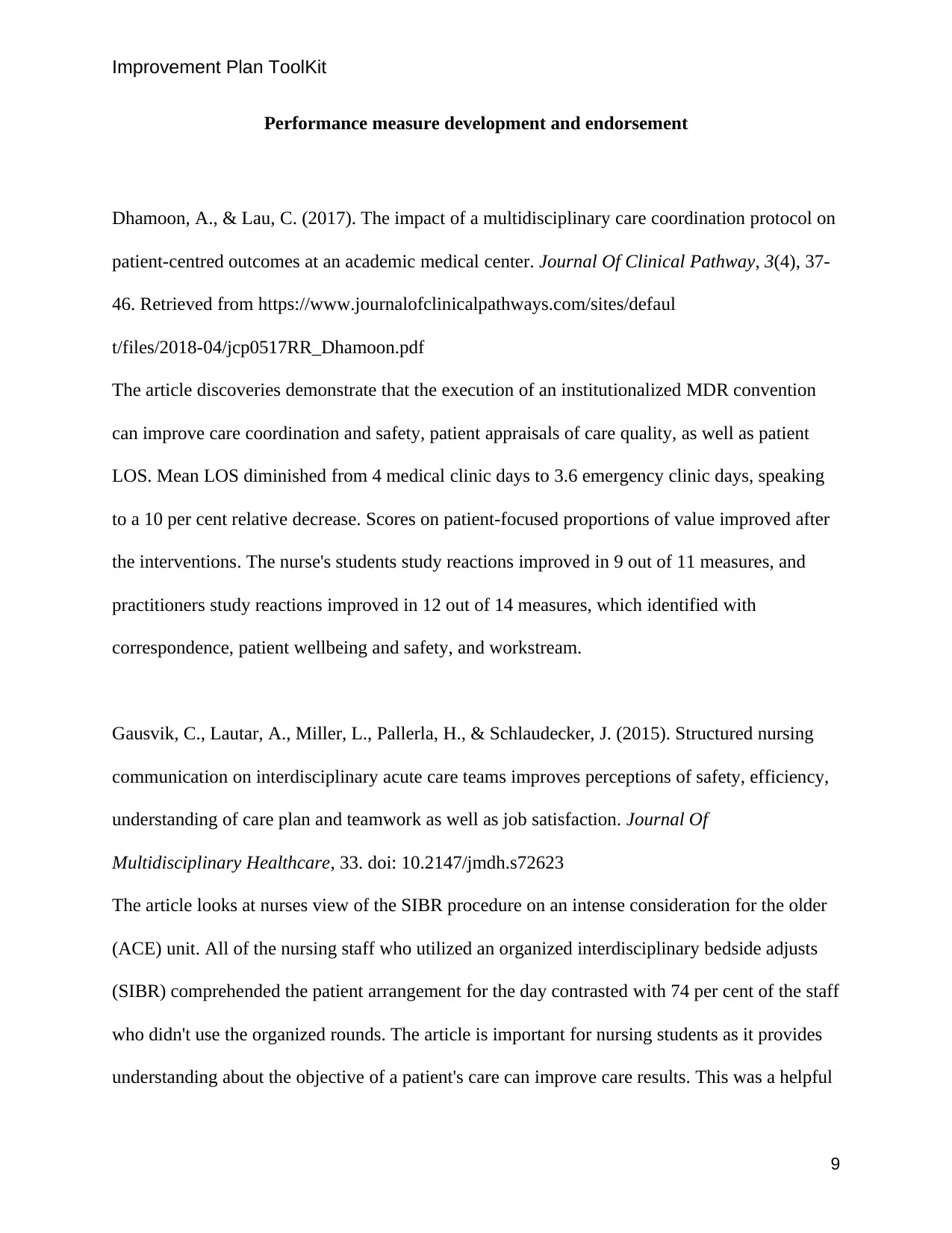
Improvement Plan ToolKit
Performance measure development and endorsement
Dhamoon, A., & Lau, C. (2017). The impact of a multidisciplinary care coordination protocol on
patient-centred outcomes at an academic medical center. Journal Of Clinical Pathway, 3(4), 37-
46. Retrieved from https://www.journalofclinicalpathways.com/sites/defaul
t/files/2018-04/jcp0517RR_Dhamoon.pdf
The article discoveries demonstrate that the execution of an institutionalized MDR convention
can improve care coordination and safety, patient appraisals of care quality, as well as patient
LOS. Mean LOS diminished from 4 medical clinic days to 3.6 emergency clinic days, speaking
to a 10 per cent relative decrease. Scores on patient-focused proportions of value improved after
the interventions. The nurse's students study reactions improved in 9 out of 11 measures, and
practitioners study reactions improved in 12 out of 14 measures, which identified with
correspondence, patient wellbeing and safety, and workstream.
Gausvik, C., Lautar, A., Miller, L., Pallerla, H., & Schlaudecker, J. (2015). Structured nursing
communication on interdisciplinary acute care teams improves perceptions of safety, efficiency,
understanding of care plan and teamwork as well as job satisfaction. Journal Of
Multidisciplinary Healthcare, 33. doi: 10.2147/jmdh.s72623
The article looks at nurses view of the SIBR procedure on an intense consideration for the older
(ACE) unit. All of the nursing staff who utilized an organized interdisciplinary bedside adjusts
(SIBR) comprehended the patient arrangement for the day contrasted with 74 per cent of the staff
who didn't use the organized rounds. The article is important for nursing students as it provides
understanding about the objective of a patient's care can improve care results. This was a helpful
9
Performance measure development and endorsement
Dhamoon, A., & Lau, C. (2017). The impact of a multidisciplinary care coordination protocol on
patient-centred outcomes at an academic medical center. Journal Of Clinical Pathway, 3(4), 37-
46. Retrieved from https://www.journalofclinicalpathways.com/sites/defaul
t/files/2018-04/jcp0517RR_Dhamoon.pdf
The article discoveries demonstrate that the execution of an institutionalized MDR convention
can improve care coordination and safety, patient appraisals of care quality, as well as patient
LOS. Mean LOS diminished from 4 medical clinic days to 3.6 emergency clinic days, speaking
to a 10 per cent relative decrease. Scores on patient-focused proportions of value improved after
the interventions. The nurse's students study reactions improved in 9 out of 11 measures, and
practitioners study reactions improved in 12 out of 14 measures, which identified with
correspondence, patient wellbeing and safety, and workstream.
Gausvik, C., Lautar, A., Miller, L., Pallerla, H., & Schlaudecker, J. (2015). Structured nursing
communication on interdisciplinary acute care teams improves perceptions of safety, efficiency,
understanding of care plan and teamwork as well as job satisfaction. Journal Of
Multidisciplinary Healthcare, 33. doi: 10.2147/jmdh.s72623
The article looks at nurses view of the SIBR procedure on an intense consideration for the older
(ACE) unit. All of the nursing staff who utilized an organized interdisciplinary bedside adjusts
(SIBR) comprehended the patient arrangement for the day contrasted with 74 per cent of the staff
who didn't use the organized rounds. The article is important for nursing students as it provides
understanding about the objective of a patient's care can improve care results. This was a helpful
9
⊘ This is a preview!⊘
Do you want full access?
Subscribe today to unlock all pages.

Trusted by 1+ million students worldwide
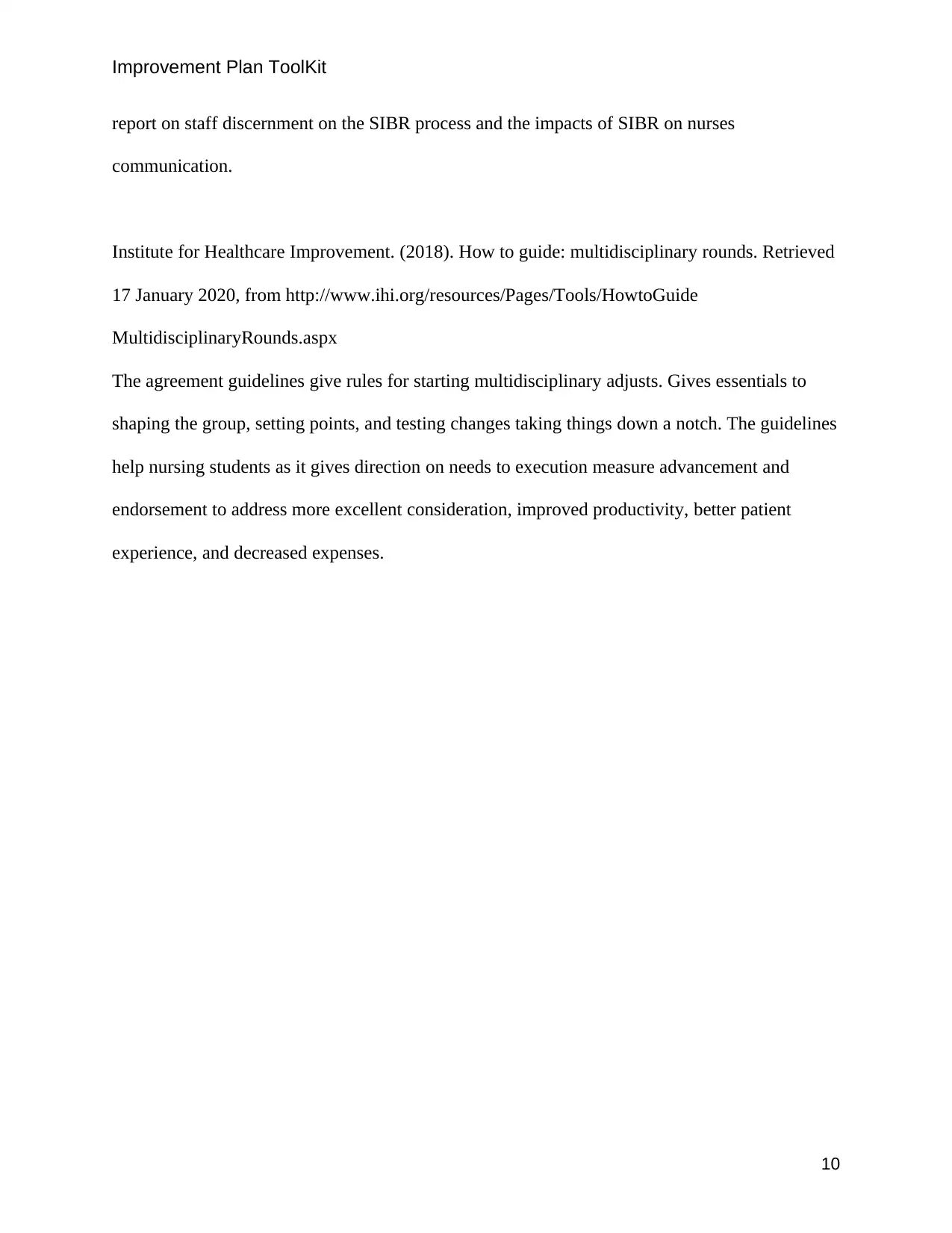
Improvement Plan ToolKit
report on staff discernment on the SIBR process and the impacts of SIBR on nurses
communication.
Institute for Healthcare Improvement. (2018). How to guide: multidisciplinary rounds. Retrieved
17 January 2020, from http://www.ihi.org/resources/Pages/Tools/HowtoGuide
MultidisciplinaryRounds.aspx
The agreement guidelines give rules for starting multidisciplinary adjusts. Gives essentials to
shaping the group, setting points, and testing changes taking things down a notch. The guidelines
help nursing students as it gives direction on needs to execution measure advancement and
endorsement to address more excellent consideration, improved productivity, better patient
experience, and decreased expenses.
10
report on staff discernment on the SIBR process and the impacts of SIBR on nurses
communication.
Institute for Healthcare Improvement. (2018). How to guide: multidisciplinary rounds. Retrieved
17 January 2020, from http://www.ihi.org/resources/Pages/Tools/HowtoGuide
MultidisciplinaryRounds.aspx
The agreement guidelines give rules for starting multidisciplinary adjusts. Gives essentials to
shaping the group, setting points, and testing changes taking things down a notch. The guidelines
help nursing students as it gives direction on needs to execution measure advancement and
endorsement to address more excellent consideration, improved productivity, better patient
experience, and decreased expenses.
10
Paraphrase This Document
Need a fresh take? Get an instant paraphrase of this document with our AI Paraphraser
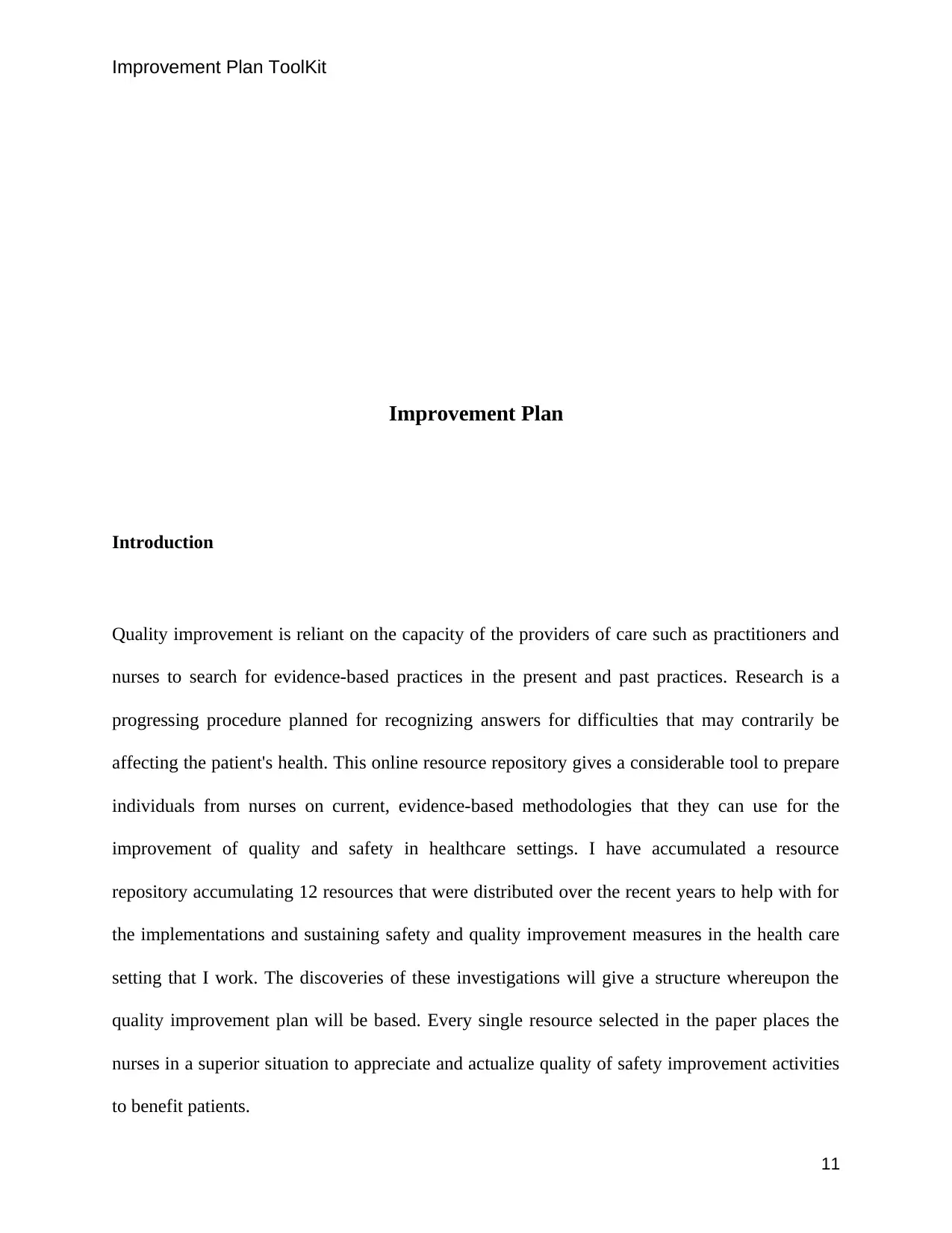
Improvement Plan ToolKit
Improvement Plan
Introduction
Quality improvement is reliant on the capacity of the providers of care such as practitioners and
nurses to search for evidence-based practices in the present and past practices. Research is a
progressing procedure planned for recognizing answers for difficulties that may contrarily be
affecting the patient's health. This online resource repository gives a considerable tool to prepare
individuals from nurses on current, evidence-based methodologies that they can use for the
improvement of quality and safety in healthcare settings. I have accumulated a resource
repository accumulating 12 resources that were distributed over the recent years to help with for
the implementations and sustaining safety and quality improvement measures in the health care
setting that I work. The discoveries of these investigations will give a structure whereupon the
quality improvement plan will be based. Every single resource selected in the paper places the
nurses in a superior situation to appreciate and actualize quality of safety improvement activities
to benefit patients.
11
Improvement Plan
Introduction
Quality improvement is reliant on the capacity of the providers of care such as practitioners and
nurses to search for evidence-based practices in the present and past practices. Research is a
progressing procedure planned for recognizing answers for difficulties that may contrarily be
affecting the patient's health. This online resource repository gives a considerable tool to prepare
individuals from nurses on current, evidence-based methodologies that they can use for the
improvement of quality and safety in healthcare settings. I have accumulated a resource
repository accumulating 12 resources that were distributed over the recent years to help with for
the implementations and sustaining safety and quality improvement measures in the health care
setting that I work. The discoveries of these investigations will give a structure whereupon the
quality improvement plan will be based. Every single resource selected in the paper places the
nurses in a superior situation to appreciate and actualize quality of safety improvement activities
to benefit patients.
11
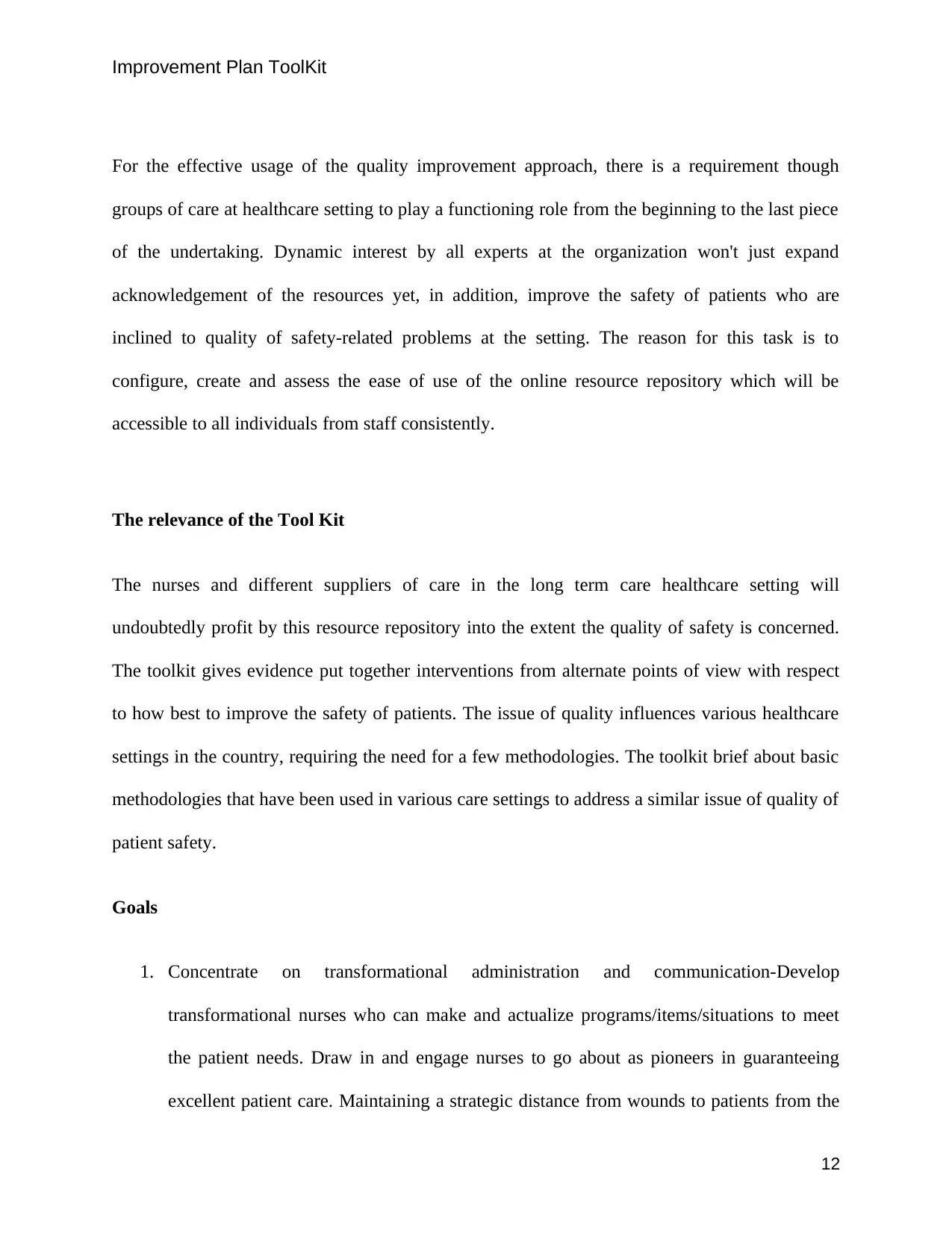
Improvement Plan ToolKit
For the effective usage of the quality improvement approach, there is a requirement though
groups of care at healthcare setting to play a functioning role from the beginning to the last piece
of the undertaking. Dynamic interest by all experts at the organization won't just expand
acknowledgement of the resources yet, in addition, improve the safety of patients who are
inclined to quality of safety-related problems at the setting. The reason for this task is to
configure, create and assess the ease of use of the online resource repository which will be
accessible to all individuals from staff consistently.
The relevance of the Tool Kit
The nurses and different suppliers of care in the long term care healthcare setting will
undoubtedly profit by this resource repository into the extent the quality of safety is concerned.
The toolkit gives evidence put together interventions from alternate points of view with respect
to how best to improve the safety of patients. The issue of quality influences various healthcare
settings in the country, requiring the need for a few methodologies. The toolkit brief about basic
methodologies that have been used in various care settings to address a similar issue of quality of
patient safety.
Goals
1. Concentrate on transformational administration and communication-Develop
transformational nurses who can make and actualize programs/items/situations to meet
the patient needs. Draw in and engage nurses to go about as pioneers in guaranteeing
excellent patient care. Maintaining a strategic distance from wounds to patients from the
12
For the effective usage of the quality improvement approach, there is a requirement though
groups of care at healthcare setting to play a functioning role from the beginning to the last piece
of the undertaking. Dynamic interest by all experts at the organization won't just expand
acknowledgement of the resources yet, in addition, improve the safety of patients who are
inclined to quality of safety-related problems at the setting. The reason for this task is to
configure, create and assess the ease of use of the online resource repository which will be
accessible to all individuals from staff consistently.
The relevance of the Tool Kit
The nurses and different suppliers of care in the long term care healthcare setting will
undoubtedly profit by this resource repository into the extent the quality of safety is concerned.
The toolkit gives evidence put together interventions from alternate points of view with respect
to how best to improve the safety of patients. The issue of quality influences various healthcare
settings in the country, requiring the need for a few methodologies. The toolkit brief about basic
methodologies that have been used in various care settings to address a similar issue of quality of
patient safety.
Goals
1. Concentrate on transformational administration and communication-Develop
transformational nurses who can make and actualize programs/items/situations to meet
the patient needs. Draw in and engage nurses to go about as pioneers in guaranteeing
excellent patient care. Maintaining a strategic distance from wounds to patients from the
12
⊘ This is a preview!⊘
Do you want full access?
Subscribe today to unlock all pages.

Trusted by 1+ million students worldwide
1 out of 19
Related Documents
Your All-in-One AI-Powered Toolkit for Academic Success.
+13062052269
info@desklib.com
Available 24*7 on WhatsApp / Email
![[object Object]](/_next/static/media/star-bottom.7253800d.svg)
Unlock your academic potential
Copyright © 2020–2025 A2Z Services. All Rights Reserved. Developed and managed by ZUCOL.





